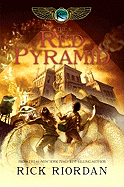
This is no April Fools' joke: Rick Riordan will launch a new middle-grade series on May 4. For anyone who was afraid he couldn't top his Percy Jackson series or his initial title in the 39 Clues, fear no more. Riordan mined Greek myths for the lineage of his campers at Half-Blood. Now he drills into the depths of Egyptian history and lore for the page-turning Kane Chronicles. Fourteen-year-old Carter Kane (named for Howard Carter, who discovered King Tut's tomb) alternates his first-person narrative with that of his 12-year-old sister, Sadie. The novel begins with a warning that the book itself is a "transcript of a digital recording," and, Carter adds, "the story we're about to tell you isn't complete yet. How it ends will depend on you." The situation is a bit complicated: after the mysterious death of their anthropologist mother (next to Cleopatra's Needle in London) and a "big court battle," their father, "an Egyptologist," won custody of Carter, and Sadie went to live with their maternal grandparents, the Fausts. The book starts with a bang--literally. On Christmas Eve, Dr. Kane picks up his daughter in London, and takes his two children to the British Museum, where he blows up the Rosetta Stone; the explosion unleashes five gods, one of whom entombs him. Naturally, the children want to rescue their father.
Their mission leads to the best kind of detective work: decoding hieroglyphics; breaking into their father's library, where they find clues to their family tree; and discovering that Sadie's cat, Muffin, is no feline at all (she's actually Bast, goddess of cats). And might the amulet given to each of the Kane children be a clue to the strange powers they're developing? Riordan has a field day, tying the children's lineage to "the Blood of the Pharaohs," and imparting Egyptian history as he weaves his spellbinding tale. Plenty of humor keeps things light, as in Sadie's contemplation of papyrus, made from a river plant: "The stuff was so thick and rough, it made me wonder if the poor Egyptians had had to use toilet papyrus. If so, no wonder they walked sideways." Riordan also explores more serious themes. Their father is African-American, their mother was blonde and blue-eyed. Carter takes after his dad, and Sadie looks like her mom, which presents some interesting opportunities for a discussion of what defines a family, and the insidiousness of prejudice ("Doesn't matter how open-minded or polite people think they are, there's always that moment of confusion that flashes across their faces when they realize Sadie is part of our family," Carter observes. "I hate it, but over the years, I've come to expect it"). Their father's release of the quintet of gods sets off a whole chain of events, including... could his own children be hosts to the gods? Readers will be clamoring for the next installment.--Jennifer M. Brown

